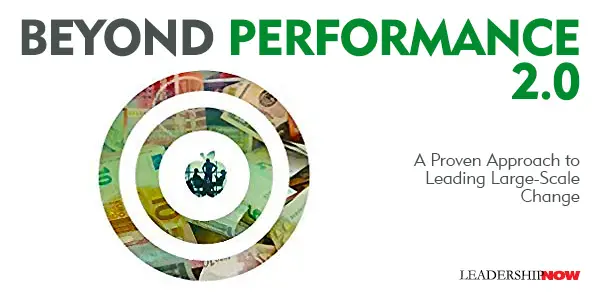 |
 |
02.19.20

Organizational Health and Performance: Beyond Performance 2.0
PERHAPS it goes without saying, but a healthy organization will achieve more than an organization that is too sick to support your goals. So, any change effort will be more successful when you focus on both performance and health. Considering that most change efforts only succeed 30% of the time, Scott Keller and Bill Schaninger (both McKinsey partners) put forth a change model to increase the odds of success (upwards of 79% of the time) in Beyond Performance 2.0. Successful change efforts are increased when we place equal emphasis on both performance and health-related efforts. The authors define performance as “what an enterprise does to deliver improved results for its stakeholders in financial and operational terms. Health is about the how. “Health is how effectively an organization works together in pursuit of a common goal. A more memorable way to think about health-related actions is that they are those that improve how an organization internally aligns itself, executes with excellence, and renews itself to sustainably achieve performance aspirations in its ever-changing external environment.”
An overemphasis on performance often causes a negative impact on organizational health leading to catastrophic failures in performance. We need t look no further than Volkswagen’s “dieselgate” scandal in 2015. Poor organizational health lead to cutting corners and rule-breaking. Samsung’s 2016 Galaxy Note 7 smartphone recall was attributed to its “deeply entrenched culture of urgency.” An equal focus on health would have mitigated these issues. An emphasis on both performance and health can be mace part of the change process by applying what they call the Five Frames of Performance and Health. The framework revolves around five questions:
Each of these questions is addressed in the framework for performance and health. These are the five frameworks for performance:
Here are the five frameworks for health:
What makes this all work is being intentional about both issues at the same time. They work with each other to bring you lasting change. The better the health of the organization the better your performance, and as your performance improves, it boosts your organizational health. The relationship is dynamic and not linear. As you move forward, plans change, conditions change, and assumptions are challenged. When this happens, you simply go back to, for example, the Assess question, “How ready are we to go there?” and make adjustments as necessary. An added benefit of this framework is that as you reach your goals, the organization learns and applies those learnings increasing the organization’s capacity for renewal. It moves you out of static thinking and into a learning mindset. And while our environment is continually changing, we have control over organizational health and therefore, can reap the increased adaptability it brings in spite of our circumstances. Gary Hamel put it well in his forward to our first addition, “Beyond Performance is far more than a guide to leading a successful change program. It’s a manifesto for a new way of thinking about [how] organizations … become, fundamentally, pro-change.” It’s not just about getting ahead; it’s about staying ahead. 
Posted by Michael McKinney at 08:15 AM
|
BUILD YOUR KNOWLEDGE
 

How to Do Your Start-Up Right STRAIGHT TALK FOR START-UPS 
Grow Your Leadership Skills NEW AND UPCOMING LEADERSHIP BOOKS 
Leadership Minute BITE-SIZE CONCEPTS YOU CAN CHEW ON 
Classic Leadership Books BOOKS TO READ BEFORE YOU LEAD |